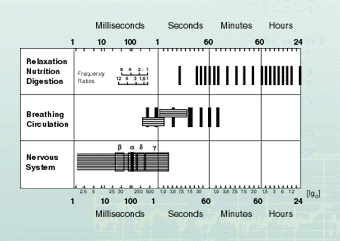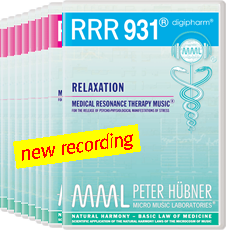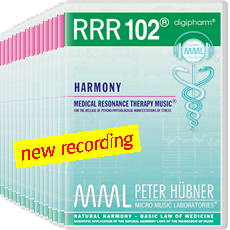| SONNEN CENTER |
| SCIENTIFICALLY INTRODUCING UNIVERSALITY TO THE UNIVERSITY |
Prof. Dr. med. Gunther Hildebrandt • Chronobiological Aspects of Music Physiology
This functional three-structuring of the endogenous-autonomic system also shows itself in a different behavior of performance of the individual rhythmic processes
(illustration 7).
Thus, the performance of the information system is expressed in the gliding frequency changes of the nerval action rhythm, whereby each frequency is in close correlation to level of excitement of the nervous elements, and therefore also to the intensity of the specific environmental effects which hit them. With acoustic stimuli, the pitch is also illustrated in the nerval rhythm. Only under peaceful conditions and especially during sleep, are the nervous elements, dependent on the depth of sleep, synchronized to tissue rhythms with favored frequency bands (cf. the EEG-criteria for depth of sleep).
(illustration 7).
Thus, the performance of the information system is expressed in the gliding frequency changes of the nerval action rhythm, whereby each frequency is in close correlation to level of excitement of the nervous elements, and therefore also to the intensity of the specific environmental effects which hit them. With acoustic stimuli, the pitch is also illustrated in the nerval rhythm. Only under peaceful conditions and especially during sleep, are the nervous elements, dependent on the depth of sleep, synchronized to tissue rhythms with favored frequency bands (cf. the EEG-criteria for depth of sleep).

Illustration 7
The frequency pattern of the endogenous-autonomic rhythms in the three functional areas of the spectrum of illustration 6. The vertical thick line describe preferential periodic duration and/or norms of frequency, the horizontally shaded fields mark the areas of frequency modulation.
The periodic duration is applied dual-logarithmically on the abscissa, so that the scale of frequency conditions in the top left field applies in all areas of the spectrum.
(According to HILDEBRANDT 1986)
| MEDICAL RESONANCE THERAPY MUSIC® Medical Music Preparations on CD |
| Listening Program: Relaxation 
Listening Program: Harmony  |
|
If you like to look at the complete program, |